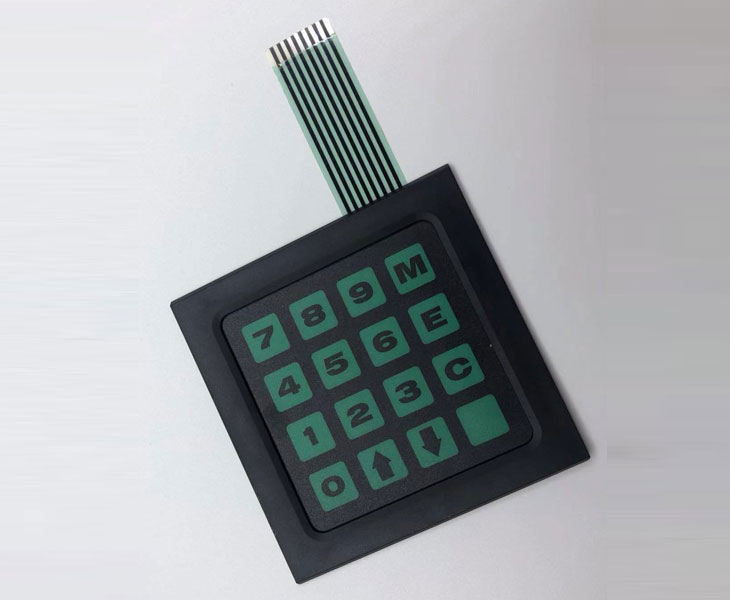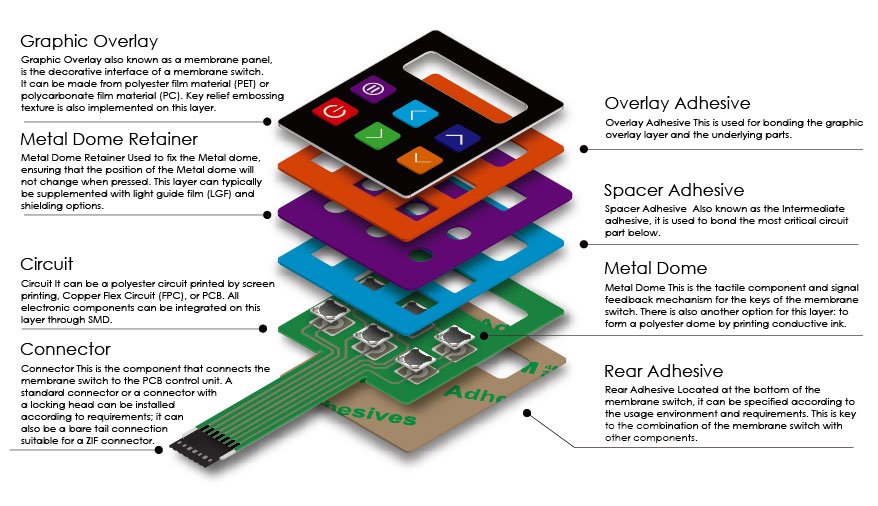All Concerning Membrane Switch Over: A Comprehensive Guide for Beginners
Membrane layer switches are important parts in contemporary electronic devices, using an unique user interface for user communication - membrane switch. Their layered building and construction, including overlays and conductive traces, supplies functionality and longevity. Unlike conventional mechanical buttons, membrane switches provide a streamlined style and personalized options. Recognizing their crucial attributes and advantages can transform item design. Nevertheless, the complexities of their application and layout factors to consider require further expedition
What Is a Membrane layer Switch over?
A membrane button is a sort of electrical button that includes an adaptable membrane layer layered over a printed motherboard. This layout allows for a streamlined and compact interface, frequently made use of in numerous electronic devices. Membrane switches are frequently located in consumer appliances, medical equipment, and commercial machinery because of their resilience and resistance to ecological factors.The building normally includes multiple layers, such as visuals overlays and sticky backing, which supply responsive comments and protect the wiring beneath. The operation of a membrane layer switch is started when stress is applied to the surface area, completing an electric circuit.These buttons are valued for their convenience, enabling personalized styles and published graphics that deal with details customer interfaces. Their low-profile nature decreases area requirements, making them suitable for applications where typical buttons might not fit. Generally, membrane buttons provide a functional and visual solution for contemporary electronic devices.
Key Elements of Membrane Layer Switches Over
Membrane changes comprise numerous key elements that add to their performance and performance. The top layer, understood as the overlay, gives the interface and is often printed with graphics or signs. Below the overlay exists a spacer layer, which divides the conductive elements and protects against unintentional activation. The next crucial component is the graphic layer, which enhances looks and assures the longevity of the design.Conductive traces, generally made from products like silver or carbon, are published on the circuit layer. When pressure is put on the overlay, these traces enter into contact, finishing the circuit. In addition, a support layer supplies structural assistance and can be made from products such as polyester or polycarbonate. With each other, these elements develop a trustworthy, easy to use user interface appropriate for numerous applications, from home home appliances to industrial tools. Understanding these elements is vital for anybody curious about membrane switch modern technology.
Exactly How Membrane Switches Job
Recognizing just how membrane layer changes function is essential for appreciating their prevalent use in numerous devices. A membrane button runs with a collection of layers, including a visuals overlay, spacer, and a circuit layer. When pressure is used to the overlay, it compresses the spacer layer, enabling the circuit layer to make call and finish an electrical circuit. This action sends out a signal to the tool, motivating a reaction, such as switching on a light or activating a function.Membrane changes can be made with various attributes, including responsive comments, backlighting, and custom-made graphics, improving individual interaction. Their construction permits a covered design, securing the internal parts from dust, moisture, and pollutants. This sturdiness makes them appropriate for diverse applications, from customer electronics to commercial tools. Generally, the simpleness and performance of membrane changes add to their popularity in modern-day technology.
Benefits of Membrane Layer Changes Over Mechanical Buttons
While mechanical switches have long been a staple in many devices, membrane changes offer distinctive benefits that make them increasingly appealing. One considerable benefit is their slim account, enabling more portable designs and higher flexibility in product development. Furthermore, membrane changes attribute a consistent surface area, which enhances aesthetic allure and streamlines cleaning, making them appropriate for environments where hygiene is critical.Another benefit is their resistance to dust and dampness. Unlike mechanical buttons, which can be compromised by ecological variables, membrane switches offer a covered interface that safeguards against pollutants - membrane switch. Membrane layer switches usually have a longer life-span due to fewer relocating components, resulting in boosted durability and reliability.Cost-effectiveness is likewise a notable benefit, as membrane layer buttons can be produced in mass with reduced manufacturing prices. These aspects combine to position membrane switches as a practical alternative to standard mechanical choices in numerous applications
Usual Applications of Membrane Switches Over
Membrane layer buttons are widely made use of in various markets, particularly in consumer electronic devices and commercial control panels. In customer tools, they give a smooth, user-friendly interface, while in industrial setups, they enhance durability and capability. Understanding these applications highlights the flexibility and functionality of membrane layer switches in contemporary innovation.
Consumer Electronics Gadgets
As consumer electronics proceed to develop, membrane buttons have actually come to be a popular choice for a variety of tools as a result of their flexibility and smooth style. These buttons are frequently located in smart devices, tablets, and remote controls, where area is minimal and looks matter. Their reduced profile and personalized designs allow makers to develop easy to use user interfaces that improve the total user experience. Furthermore, membrane layer switches are frequently made use of in devices such as microwaves and coffee makers, providing instinctive control options while withstanding moisture and dirt. The durability and integrity of membrane layer switches make them suitable for everyday consumer products, making certain use this link durability and consistent efficiency. Generally, their integration in consumer electronics reflects a blend of functionality and contemporary design.
Industrial Control Panels
The applications of membrane switches prolong beyond customer electronics, finding significant usage in commercial control panels. These buttons are preferred for their toughness and resistance to harsh atmospheres, making them perfect for making and procedure control settings. They provide a dependable interface for drivers to regulate equipment, monitor processes, and adjust settings. Membrane switches can be personalized to match specific operational requirements, incorporating attributes like backlighting and tactile responses, enhancing individual experience. Their inconspicuous design enables integration right into various tools, while their ability to withstand spills, dirt, and extreme temperature levels warranties longevity. In general, membrane layer buttons add to risk-free and reliable operation in commercial applications, demonstrating their convenience and performance sought after environments.
Considerations for Designing Membrane Layer Switches
When developing membrane buttons, picking the appropriate materials is vital to ensure resilience and capability. Furthermore, understanding layer arrangement methods can substantially affect the button's performance and customer experience. These considerations play an essential role in creating reputable and efficient Visit Your URL membrane button designs.
Product Choice Significance
Product selection plays a crucial duty in the design and functionality of membrane buttons. The selected materials straight impact the switch's sturdiness, responsive response, and total aesthetic. Trick factors to consider consist of the substratum, which need to offer architectural stability while permitting versatility, and the graphic overlay, which needs to be immune to put on and ecological aspects. Conductive products should assure reputable electrical efficiency, while adhesives must provide solid bonding without jeopardizing the switch's procedure. Furthermore, compatibility with producing procedures and end-user settings is crucial; products should endure differing temperature levels, moisture degrees, and chemical direct exposure. Inevitably, ideal product choice not just boosts the membrane switch's efficiency yet also adds to its longevity and customer complete satisfaction, making it a crucial aspect of the layout process.

Layer Setup Strategies

Frequently Asked Inquiries
Exactly How Long Do Membrane Changes Typically Last?
Membrane buttons normally have a lifespan of 1 to 5 million cycles, depending on usage and ecological problems. Factors such as design top quality and operating frequency significantly affect their toughness and total efficiency durability.

Can Membrane Changes Be Personalized for Particular Styles?
Membrane layer buttons can certainly be tailored to accommodate details styles, permitting varied forms, shades, and performances. This flexibility makes it possible for suppliers to tailor these buttons to meet unique visual and operational requirements efficiently.
What Products Are Made Use Of in Membrane Layer Change Building And Construction?
Membrane switches are generally constructed making use of materials such as polyester, polycarbonate, and sticky layers. These materials provide adaptability, resistance, and toughness to ecological factors, guaranteeing the buttons work successfully in numerous applications and conditions.
Are Membrane Switches Waterproof or Resistant to Wetness?
Membrane buttons can be made to be moisture-resistant, utilizing specialized products and finishes. Their waterproof abilities depend on building top quality and details applications, making it vital to analyze demands for suitable efficiency in various settings.
Exactly How Are Membrane Layer Switches Over Fixed if Damaged?
Fixing damaged membrane switches over usually involves changing the affected layer or circuit. Technicians may also use conductive glue or use specialized repair packages, ensuring functionality is brought back without total substitute of the whole switch assembly. Unlike conventional mechanical buttons, membrane buttons present a streamlined design and personalized alternatives. A membrane switch is a type of electric switch that consists of a flexible membrane layered over a published circuit board. The operation of a membrane switch is started when pressure is applied to the surface area, completing an electrical circuit.These buttons are valued for their versatility, enabling custom-made layouts and published graphics that cater to certain user interfaces. While mechanical switches have long been a staple in many tools, membrane switches deal distinctive benefits that make them significantly appealing. Membrane buttons normally have a longer life expectancy due to less relocating parts, resulting in enhanced resilience and reliability.Cost-effectiveness is also a notable benefit, as membrane layer buttons can be generated in mass with reduced production expenses.